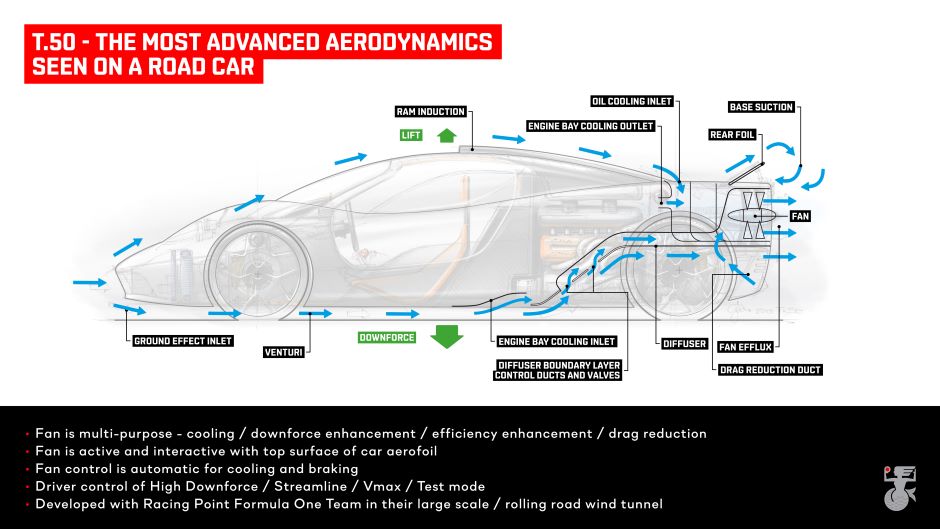
Unveiling the first official picture of the already much-hyped British sports car, to be launched in May 2020, Gordon Murray Design also revealed that it will work with the Silverstone-based Racing Point Formula One team to further develop and test its aerodynamics.
Racing Point has a rolling road windtunnel at its headquarters, with which the GMD team will tweak the advanced airflow management on which the T.50 will depend.
During his career as a Formula One designer, Gordon Murray is perhaps best known for the BT46B ground effect fan car he developed for Brabham in 1978, which used a large fan underneath the car to generate additional downforce to keep it pressed onto the track. After its one race, the sport’s governing body declared that fan cars would no longer be allowed in Formula One.
_____________________________________________________________________
Further reading
- New Gordon Murray supercar claimed to be world’s lightest
- Gordon Murray Design claims that new chassis frame technology cuts vehicle weight in half
- Gordon Murray Design’s iStream technology wins Dewar trophy
_____________________________________________________________________
Despite this setback, Murray declared that he wanted to use the ground effect fan system in a road car, and the T.50 is the embodiment of that ambition.
“Formula One remains a deep passion of mine, so partnering with Racing Point to develop the T.50 is hugely exciting. I’ve dreamt of delivering a road car with a ground-effect fan since I designed the Brabham BT46B F1 racing car in 1978,” Murray commented. “The system on the T.50 is much more sophisticated than the Brabham’s and will benefit enormously from Racing Point’s expertise and resources.”

The image GMD has released of the T.50 reveals the main component of the ground effect fan system, a 400mm fan on the back of the car. Hidden from view are active underbody aerodynamics, and dynamic rear aerofoils, part of boundary layer control ducts in the rear diffuser, which manage airflow under and around the car to optimise the ground force and balance traction and performance.
According to GMD, the car will operate with six distinct aerodynamic modes, the most extreme of which will combine motorsport slipstream technology, extra power from a 48V integrated starter-generator and ram induction to boost power to 700hp.
As such, the design requires much more dynamic testing than a conventional high-performance sports car, and GMD intends to use the partnership with Racing Point to move from software-based testing using computational fluid dynamics to physical testing, which will be performed using a 40 per cent scale model.
Racing Point team owner, Lawrence Stroll, said: “Working on the T.50 with Gordon Murray Automotive is an honour and a privilege for everyone at Racing Point. Our aerodynamicists will utilise our wind tunnel to harness the very latest Formula One expertise and experience for the T.50 project, ensuring Gordon’s revolutionary fan concept delivers its full potential. I have admired the design and engineering skills of Gordon Murray since his earliest days in Formula One, so it is a personal pleasure to support this project, which truly rewrites the rulebook on aerodynamics.”
The underbody aerodynamics allow the car to dispense with vents, flaps and ducts on its upper surfaces. The rear portion of the car also contain systems to cool powertrain oil and shed drag. These systems allow the car to operate without the distinctive “skirt” that distinguished the Brabham car.
GMD claims that in its default mode, the fan system will be able to double levels of downforce, enhancing braking at high speed. The T.50 will also feature four driver-selectable aerodynamic modes, which will enhance traction or reduce drag, depending on how they are deployed.
The car will be powered by a bespoke Cosworth V12 engine, operating at a maximum of 12,100rpm.
“We were highly focused on achieving the purest possible form for the T.50, an objective we’ve achieved through world-first engineering innovations and active underbody aerodynamics. We will reveal the completed design at the T.50 supercar’s global debut in May,” Murray said.
GMD will produce 100 of the cars, which despite a pricetag of £2m before taxes, have already all been allocated. Demand has been particularly strong in the US and Japan, the company said. Like Gordon Murray’s previous McLaren F1 road car, the T.50 will be a three-seater, with the driver sitting in a central position ahead of and between the two passengers.
“We’ve been taken aback by the enthusiastic reaction of buyers from across the globe. The first customer deliveries will take place in January 2022, on schedule, with every customer who has already been allocated their T.50 receiving their car that year,” said Murray.




Project to investigate hybrid approach to titanium manufacturing
Sadly they will not be ordering any more presses from Wilkins & Mitchell http://www.historywebsite.co.uk/articles/Darlaston/WM.htm